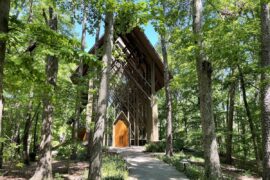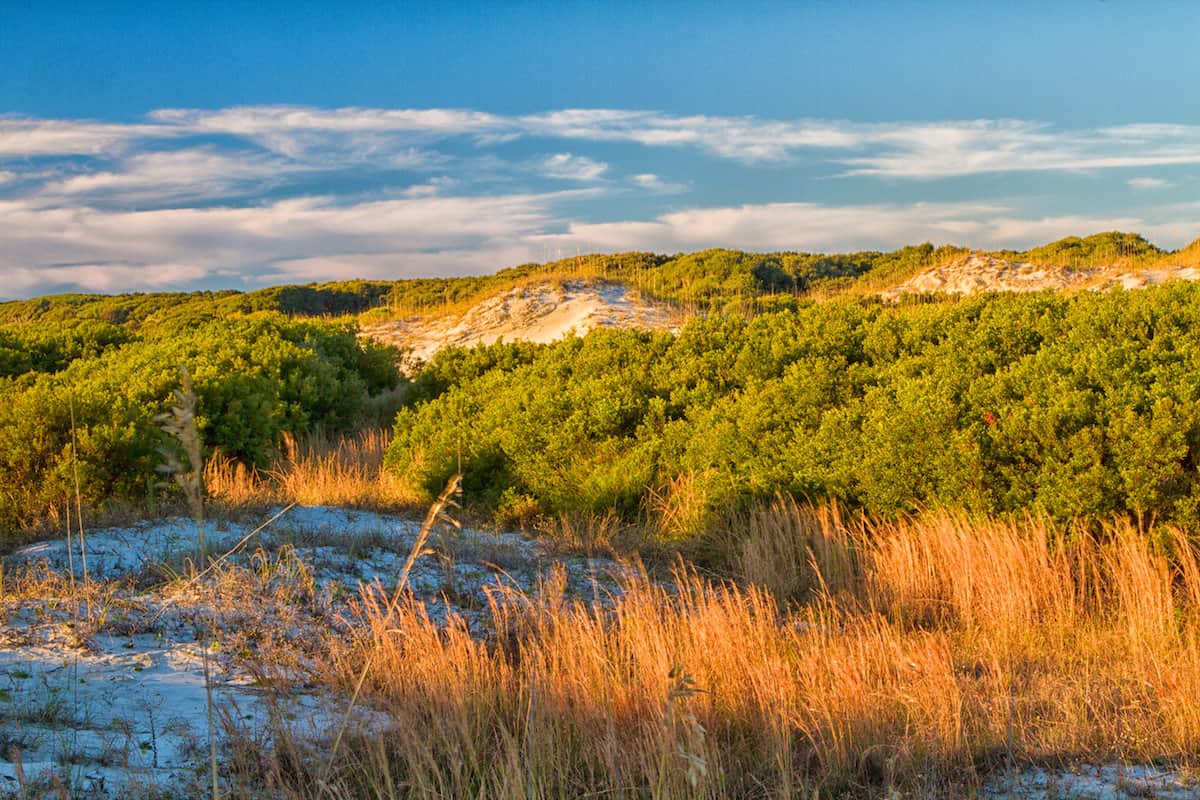
Along the Georgia coast, you can enjoy the unspoiled beauty of Cumberland Island National Seashore. As a barrier island, it boasts 17 miles of pristine beaches, wild horses and gracious mansions from a gilded era. A ferry ride from the mainland, visitors can explore the island on a bike or by hiking to see its maritime forest and wetlands, both rich in wildlife. There are even ruins to explore. Here are the top things to do on Cumberland Island.
Top Things to Do on Cumberland Island
Visit the Cumberland Island National Seashore
Walk through the Cumberland Island Visitor Center
Take the Cumberland Island Ferry for a Scenic Cruise
Walk through the Maritime Forest
See a Salt Marsh
Visit the Cumberland Island Beach
Hike to the Dungeness Ruins
Bike to the Plum Orchard Mansion
See the First African Baptist Church
Stop by the Sea Camp Ranger Station
Tour the Ice House Museum
See Wildlife on Cumberland Island
Best Hiking Trails on Cumberland Island
Bike on Cumberland Island
Earn a Junior Ranger Badge
Take a Guided Tour
Camp Out
Cumberland Island National Seashore
A national seashore protects the natural beaches in the U.S. and offers an undeveloped landscape to enjoy. On Cumberland Island, visitors will find a designated wilderness area, undeveloped beaches, historic sites and cultural areas, along with critical nesting sites and habitat areas for wildlife.
Located about six miles from St. Marys, Georgia, Cumberland Island is only accessible by boat and restricted to bikes (except for organized tour operators and a few residents still living on the island). The Cumberland Island National Seashore preserves the majority of the island, though the southern end is the easiest to explore by daytrippers from Mainland Georgia.
Walk Through the Cumberland Island Visitor Center
Located on the Mainland, this is the main information center. Visitors can get maps and booklets and find an interpretive area. This is also where they check in for the ferry.
The interpretive area features several exhibits, including information about the island’s wildlife and history. Visitors can also learn about the Timucuan culture and people who lived in the area before 1561. There is also information about the colonial era of the United States, including the War of 1812.
Visitors can also learn about the plantation era and the island’s agriculture. The museum area features the settlement area and the history of the First African Baptist Church on the North End of Cumberland Island.
In addition to information and displays, the visitor center offers a film on the “forgotten invasion” in the War of 1812.
Located at 113 St Marys St, W St Marys. Open daily from 8 a.m. to 4 p.m. To visit the Cumberland Island, the adult admission fee is $15 per person.
ProTip: The spots in front of the visitor center are mostly restricted to a certain number of hours. Down and across the street is a shaded lot that’s free and has ample parking for daytrippers.
Best Things to do in Pigeon Forge and Gatlinburg

Take the Cumberland Island Ferry for a Scenic Cruise
Before we boarded the ferry, we listened to a talk from a ranger. She gave us the ins and outs of where things were, important locations and safety information. After that, it was time to load up.
My kids have always loved “things that go.” Any kind of transportation is part of the fun for them, so they were excited about the ferry ride. It takes about 45 minutes to get to Cumberland Island, so settle in.
There are spots all around the lower and upper decks of the ferry. Inside is a seating area with tables. It was a windy day, so the youngest and I decided to park ourselves in there and get started on his Junior Ranger book.
A ferry is necessary to reach Cumberland Island since there isn’t a bridge. It departs daily from the Cumberland Visitor Center at 9 a.m. and 11:45 a.m.
The ferry returns from Cumberland Island three times a day from March 1st to September 30th at 10:15 a.m., 2:45 p.m. and 4:45 p.m. The ferry returns twice daily during the fall and winter at 10:15 a.m. and 4:45 p.m.
Adult ($16 +) round-trip passage costs $40 and youth (6 to 15) are $30.
Arriving on Cumberland Island
The ferry will dock, and visitors are free to explore, with several choices of where to start. There are guided tours for a fee that will take you around the entire island. That was a little pricey for the four of us, and I didn’t know how long my kids would be up for this adventure, so I opted to take the later ferry and self-guide.
Bikes are available for rent on the island (again, these sell out and are seasonal), or visitors can bring their own bikes on the ferry for $10/bike. Notable landmarks are the First African Baptist Church, where JFK, Jr. and Carolyn Bessette were married, Plum Orchard Mansion and the Dungeness Ruins.
The church and Plum Orchard were too far for us to walk with our youngest, so we explored the beach and the Dungeness Ruins area.
Top Things to Do in Macon Georgia
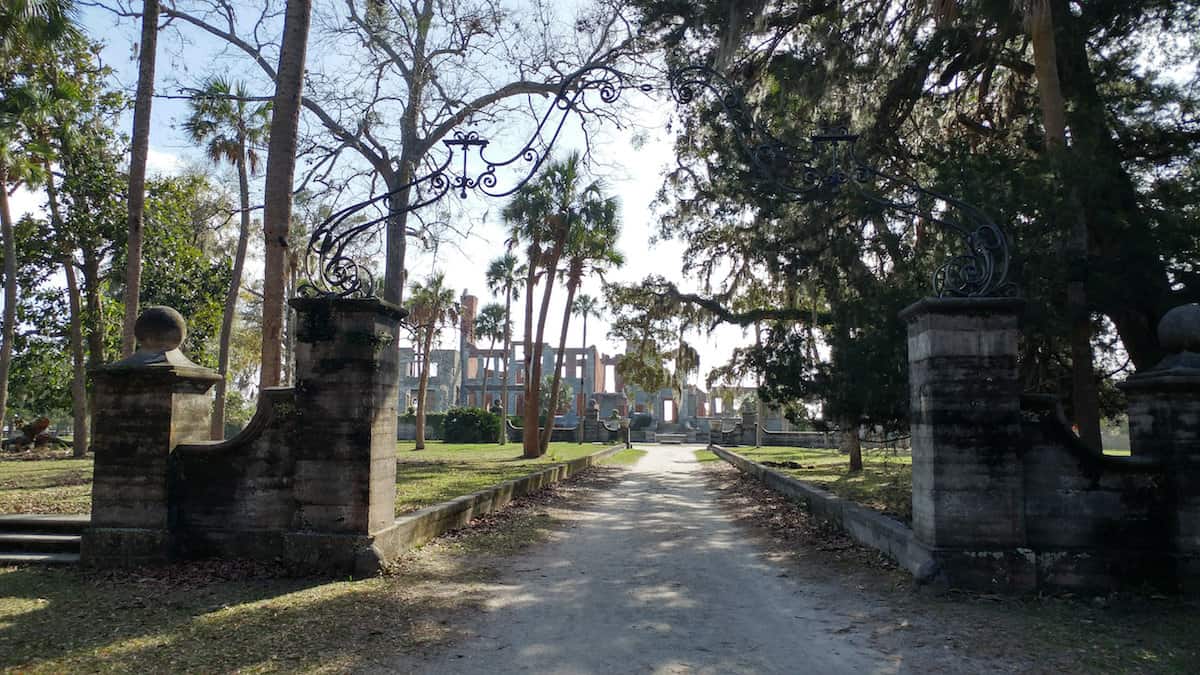
Walk through the Maritime Forest
To get to the beach, we trekked through the maritime forest. Y’all, I could have strolled through there all day. The beauty and peace of that forest was awe-inspiring. If that was all there was to Cumberland Island, I could have left happy.
The Maritime Forest is made of live oaks draped in Spanish Moss and Resurrection Ferns. Under the trees, I saw palms and ivy, including poison ivy, thrive under the branches of the live oaks. One side of the Maritime Forest transitions to the sand dunes, with the beach beyond. The other side of the forest is a salt marsh, a favorite habitat for sea birds.
See a Salt Marsh
Another part of the Cumberland Island’s ecosystem is the salt marsh. With over 9,000 acres, the salt marsh is home to fiddler craps and birds are frequently found in this area. The overlook near the Dunegress Ruins is one of the most accessible places to see the salt marshes and includes boardwalks.
Visit the Cumberland Island Beach
Since Cumberland Island isn’t a traditional tourist beach, its beauty is unspoiled. The first thing I noticed was the tall dunes.When we passed the dunes, however, I was immediately struck by the vastness of the beach. There were no plastic chairs, umbrellas or coolers—just sand, and plenty of it. In total, there are 17 miles of beach on Cumberland Island.
My oldest son was beside himself. He took off near the water, looking for shells. Visitors are allowed to keep any uninhabited shells. Soon, he was way ahead of us. We weren’t finding anything near the waterline, and I was disappointed. We wandered up closer to the dunes and hit the motherlode.
It’s hard to imagine the tides being so high when you are used to touristy beaches with much smaller beach strips. When we moved up, we found more shells than we could carry. We finally caught up to my oldest and enlightened him.
ProTip: The beach is about .5 miles from the Sea Camp Dock and accessible by a trail. There are no lifeguards on Cumberland Island, though you should inquire about rip currents at the ranger station before heading into the ocean.
Planning Guide to Great Smoky Mountains National Park
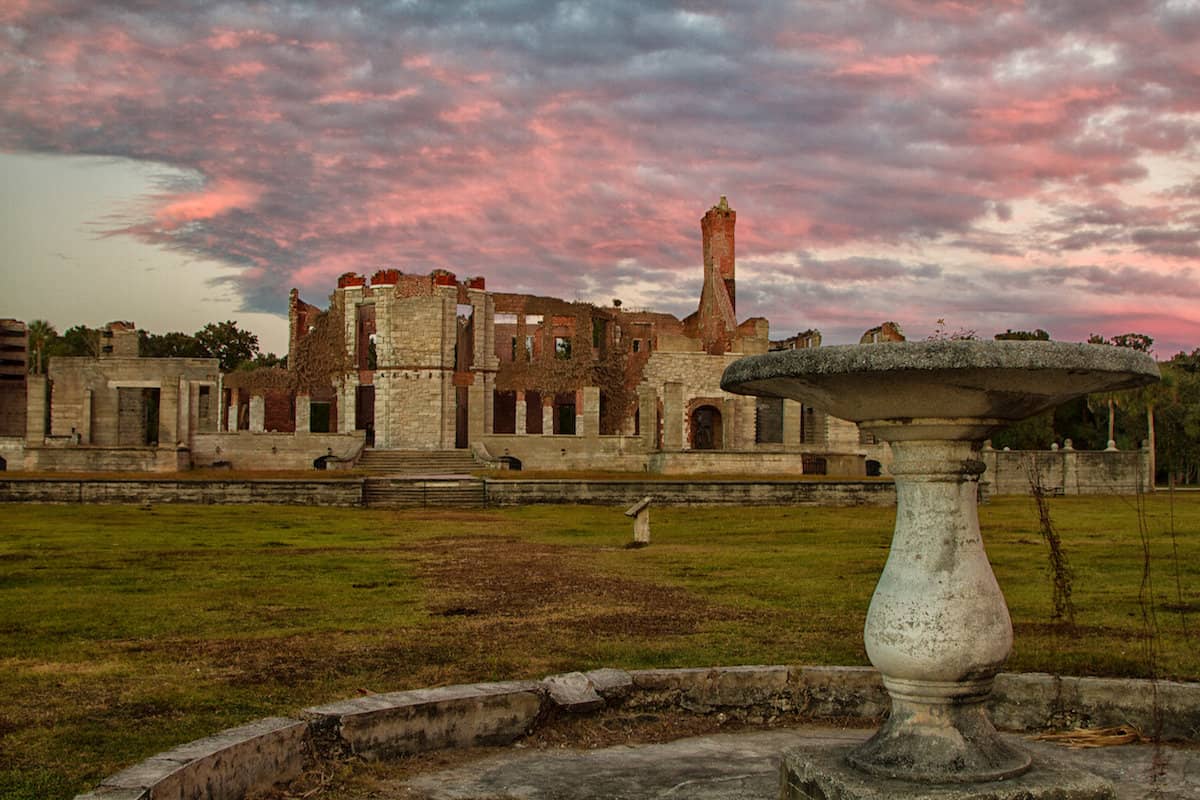
Visit the Dungeness Ruins
We left the beach and moved further inland, using several boardwalks to cross the salt marshes. I did not leave until I saw the ruins of Dungeness.
Nearby, Jekyll Island was home to the Jekyll Island Club, an exclusive club for magnates and millionaires such as the Morgans, Pulitzers, and Rockefellers. Thomas Carnegie afforded himself more privacy and purchased property on Cumberland Island. The lavish home was built in 1884 and named Dungeness, but he died before the 59-room mansion was completed. Lucy Carnegie (his widow) expanded the house several times and it had grown to 35,000 feet by the time of her death in 1916.
A fire in 1959 destroyed most of the house, though the remains are a popular spot to explore and are preserved by the National Park Service. Visitors are free to approach the building, but common sense and the Park Service dictate that no one actually go in. Even in its devastation, Dungeness is an impressive site.
Since we had been to Jekyll Island, my kids were well acquainted with the Jekyll Island Club. It was easier for them to connect the time period of this mansion and the level of wealth involved in maintaining it.
ProTip: Free Ranger tours of the Dunegress Ruins are available. Inquire at the dock upon arrival. This area offers picnic tables, restrooms and drinking water.
Top Beaches in the U.S. for Families

Bike to the Plum Orchard Mansion
Completed in 1898, the Georgian Revival Mansion is 20,000 square feet and was built by Lucy Carnegie for her son and daughter-in-law, George Carnegie and Margaret Thaw. The mansion is open for free tours.
Located seven miles north of Sea Camp dock and a 14-mile roundtrip hike from the pier, and not recommended for day trippers to the island. The Plum Orchard Mansion offers picnic tables along with restrooms and drinking water.
See the First African Baptist Church
This humble church burst onto the front page of newspapers across the U.S. when John F. Kennedy, Jr. married Carolyn Bessette in 1996 in a secret ceremony. Undiscovered by the media, the one-room church held a close group of friends and family.
Established in 1893 by residents of the island, some of which were born into slavery. This church was used for worship by people living in the Settlement area. Now, visitors can tour the church, though it is located on the northern end of the island, 14 miles from Sea Dock. Restrooms are located nearby.
Top Things to Do Near Padre Island National Seashore

Stop by the Sea Camp Ranger Station
Located close to the Sea Dock, this is the primary location for information on Cumberland Island. Prior to the 4:45 p.m. ferry back to the Mainland, visitors can attend a Ranger Program. This ranger station offers maps and information about the flora and fauna of Cumberland Island, Junior Ranger Booklets, first aid, restrooms and drinking water. It is open daily from 8:30 a.m. to 4:30 p.m.
Tour the Ice House Museum
The Carnegie Estates enjoyed ice, which was stored in an ice house (in an era before easy refrigeration and freezers). This self-guided museum, built around 1900, offers a unique look into life before modern conveniences. It features two-foot walls filled with insulation to keep the ice from melting.
Located next to the Dungeness Dock and is open from 8:30 a.m. to 4:30 p.m.
Best Birding Spots in Texas

See Wildlife on Cumberland Island
It’s everywhere, y’all. The most famous residents are the horses. Once kept as stock for work and hunting, the horses were allowed to be free range and eventually became feral. There are 130 to 170 feral horses on the island in a given year. They are not managed in any way by the park service. Do NOT approach them too closely or try to feed them. Associating people with food might negatively impact their natural survival skills and cause problems for visitors.
Birds are plentiful, as well as ghost crabs. We didn’t see any, but we know that snakes and alligators are also inhabitants. So be aware of your surroundings.
What I was not expecting to see were armadillos. I always thought they were native to Western states. These guys were all over the place near the Dungeness ruins. I had lived 46 years without seeing an armadillo in person. I can now add another life experience to my list.
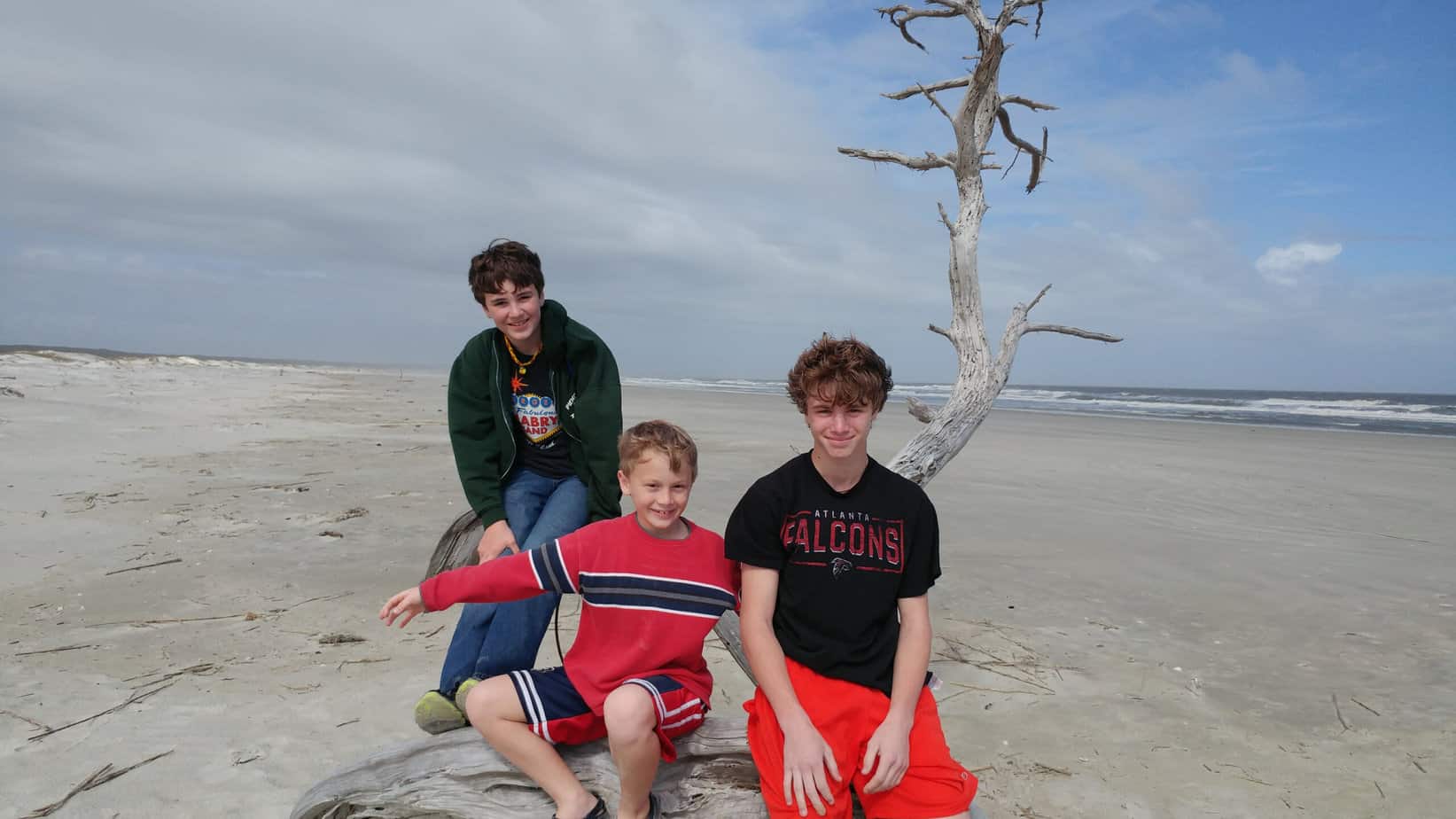
Best Hiking Trails on Cumberland Island
The island itself has over 50 miles of hiking trails. Upon arrival, grab a park map for the distances between individual sites on the island.
Sound to Sea Southend Loop—A 4.5-mile loop trail from the Sea Camp Dock past many of the popular sites on the southern end of the island, like the Ice House Museum, the Dungeness Ruins and the beach. It’s one of the most popular trails used by day visitors.
Bike on Cumberland Island
Biking is an easier way to see the island when visiting, especially Plum Orchard, which is 14 14-mile round trip from the dock. It is restricted to the unpaved roads on the island, like the Main Road. Biking on the trails and the beach is prohibited.
Sometimes, visitors can rent bikes from the island for the day. Please check in advance for bike rental options on the island. Visitors can bring their own bikes over on the ferry for $10 per bike.
Earn a Junior Ranger Badge
The Junior Ranger Program is the go-to program for families to learn about a National Park Service site. It’s free and takes about two hours to complete.
My youngest was all about getting a Junior Ranger badge. During this trip, my son received not one but two books.
- Cumberland Island—Of course, there was a book specific to this location. Inside are all kinds of activities related to the ecosystem and history of the island.
- Underwater Explorer–This is a national book that is given out at the National Seashore sites.
ProTip: Each book earns the child a badge. If you don’t want to feel rushed to finish, you can complete them at home and mail the book to the Park Service. We just focused on the Cumberland Island book.
Guide to Junior Ranger Badges
Guided Tours of Cumberland Island
Cumberland Island doesn’t allow personal vehicles, though it offers a motorized guided tour. Departing from the Sea Camp Ranger Station (where the ferry arrives), visitors will get a 5—to 6-hour tour of the island.
On the tour, visitors will visit the Plum Orchard Mansion, the remnants of Robert Stafford’s plantation and cemetery, Cumberland Wharf, the settlement and the First African Baptist Church.
Those on the tour will also travel through the maritime forests of Cumberland Island, one of the largest remaining such forests in the U.S. Cumberland Island is one of the largest undeveloped barrier islands on the Atlantic coast.
It is worth noting that due to the length of the tour, participants will not have time to visit the beaches on Cumberland Island unless they are camping overnight.
The guided tour of Cumberland Island is $65 per person, and reservations are required.
Camping on Cumberland Island
The developed sites on Cumberland Island offer fire rings and grills. All camping is leave no trace and there are no trash cans on the island. All food items need to be contained in a food storage locker.
Sea Camp Campground
- Reservations Required
- 18 Tent Only Sites
- Flush Toilets with Cold Water Showers
- Potable Water Spigots and a Dishwashing Sink
- Picnic Tables
Stafford Beach Campground
- Reservations Required
- 10 Tent-Only Sites
- Flush Toilets with Cold Water Showers
- Potable Water
Cumberland Island features three wilderness campsites that are hike-in sites with four spots per campground. Water must be treated and offer no facilities. Food will have to be hung in trees.
- Hickory Hill Wilderness Campsite
- Yankee Paradise Wilderness Campsite
- Brickhill Bluff Wilderness Campsite
Where to Stay on Cumberland Island
Greyfield Inn
For an unforgettable stay, Greyfield Inn is a historic Inn featuring 15 antique-filled rooms originally built by the Carnegies. The gracious home serves all meals, including lunch in picnic baskets and Hors d’oeuvres in the early evening. Each of the accommodations is individually decorated with an eye toward the historic nature of the property.
Activities include hiking and kayaking, and Greyfield Inn offers its guests bikes for their stay. A minimum night’s stay is required, and the Greyfield Inn offers a private ferry. For rates and more information, visit its website.
Know Before You Go:
- Sunscreen is a must; We walked facing the sun and the beach. It was a windy day, and I wasn’t hot, so I wasn’t thinking about sunburns. It was definitely brought to my attention later.
- Get your tickets in advance. I purchased ours before leaving home. There are a limited number of people allowed on the island per day, and trips can sell out.
- Allow time for check-in. Even if you purchased tickets early, you still have to check in at the desk inside. There can be lines, so plan accordingly. If you haven’t checked in 20 minutes before departure, they will start giving away spots to walk-ups.
- The ferry only travels to and from the island a couple of times daily. Once you are there, you are there for hours. There is no concession service on the island, so you must bring your own food, sunscreen and bug spray. There are restrooms. I cannot stress enough how important it is to make sure you have enough food and water for your family, along with comfortable shoes.

